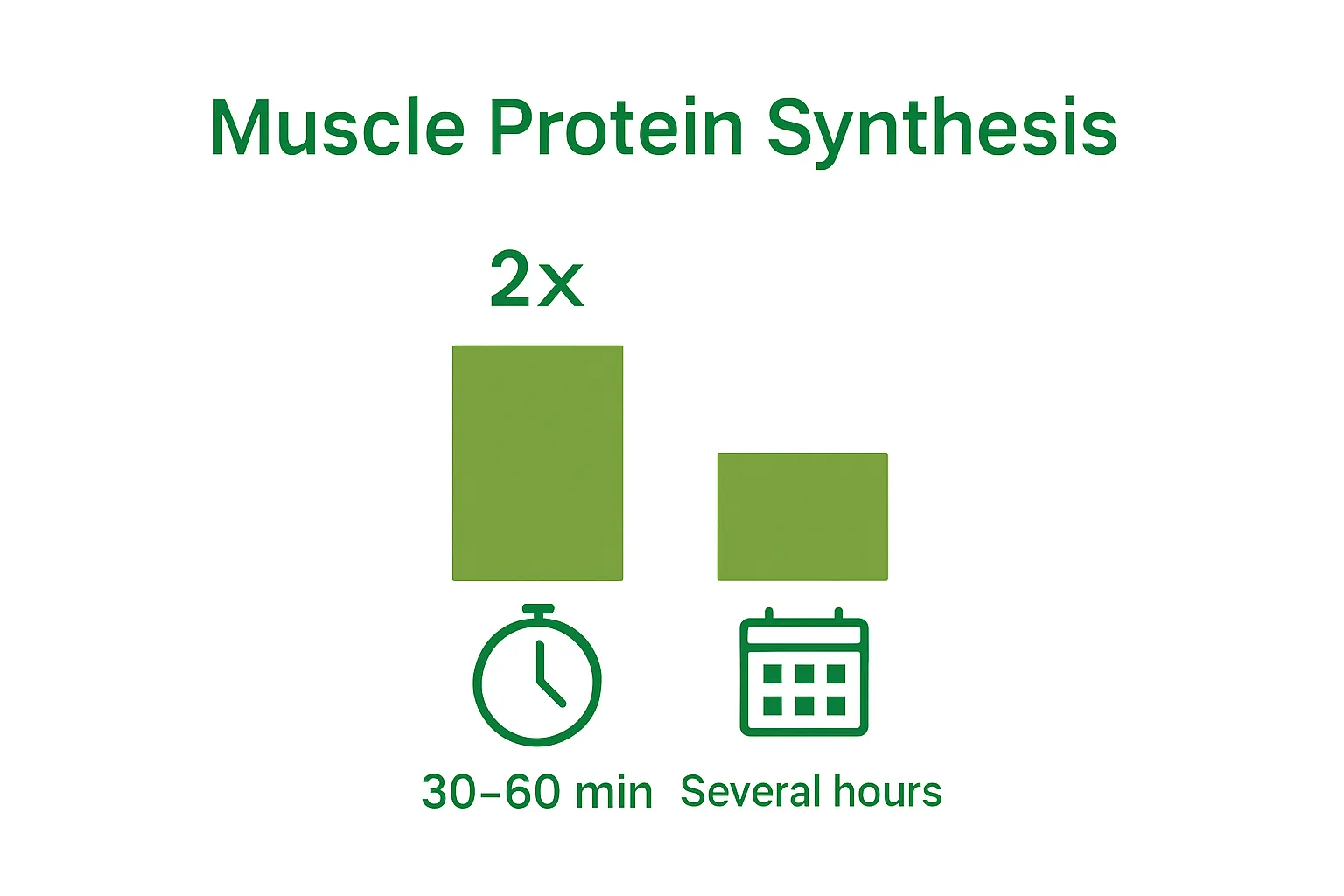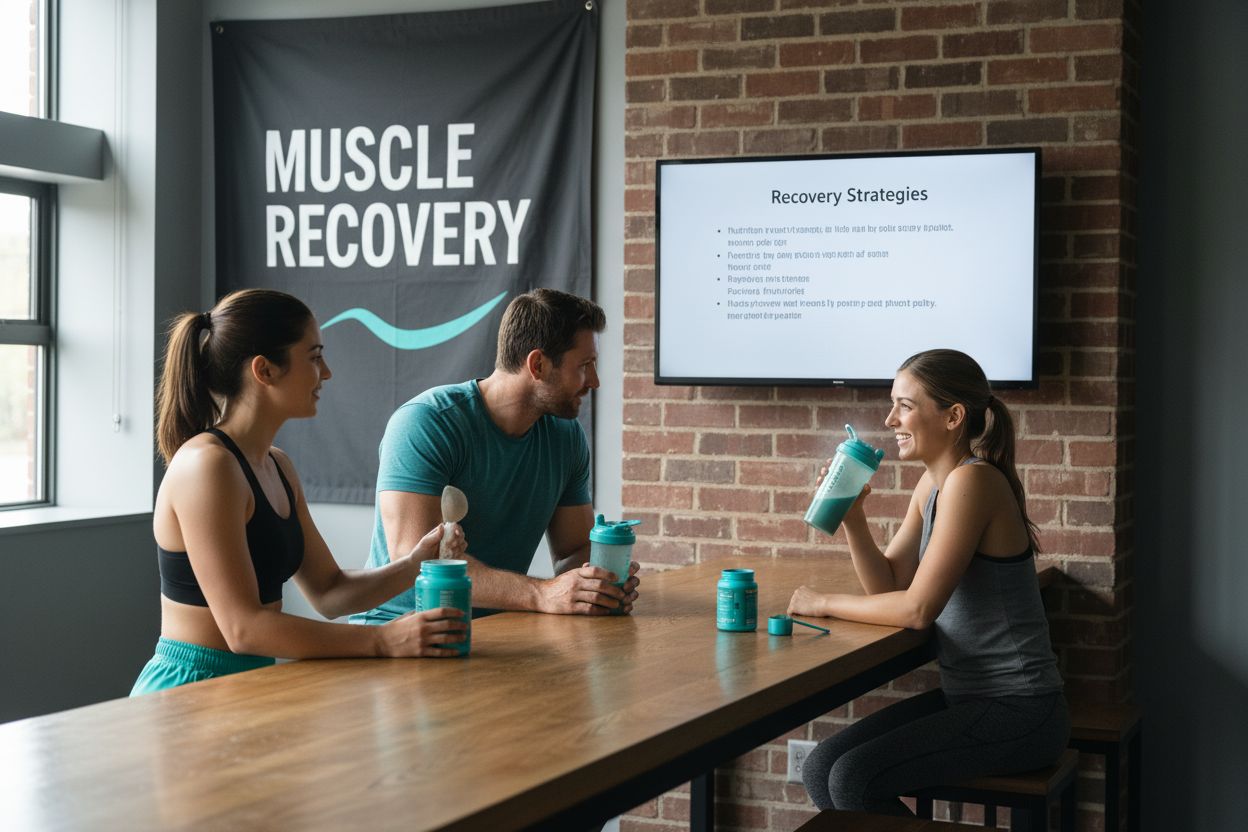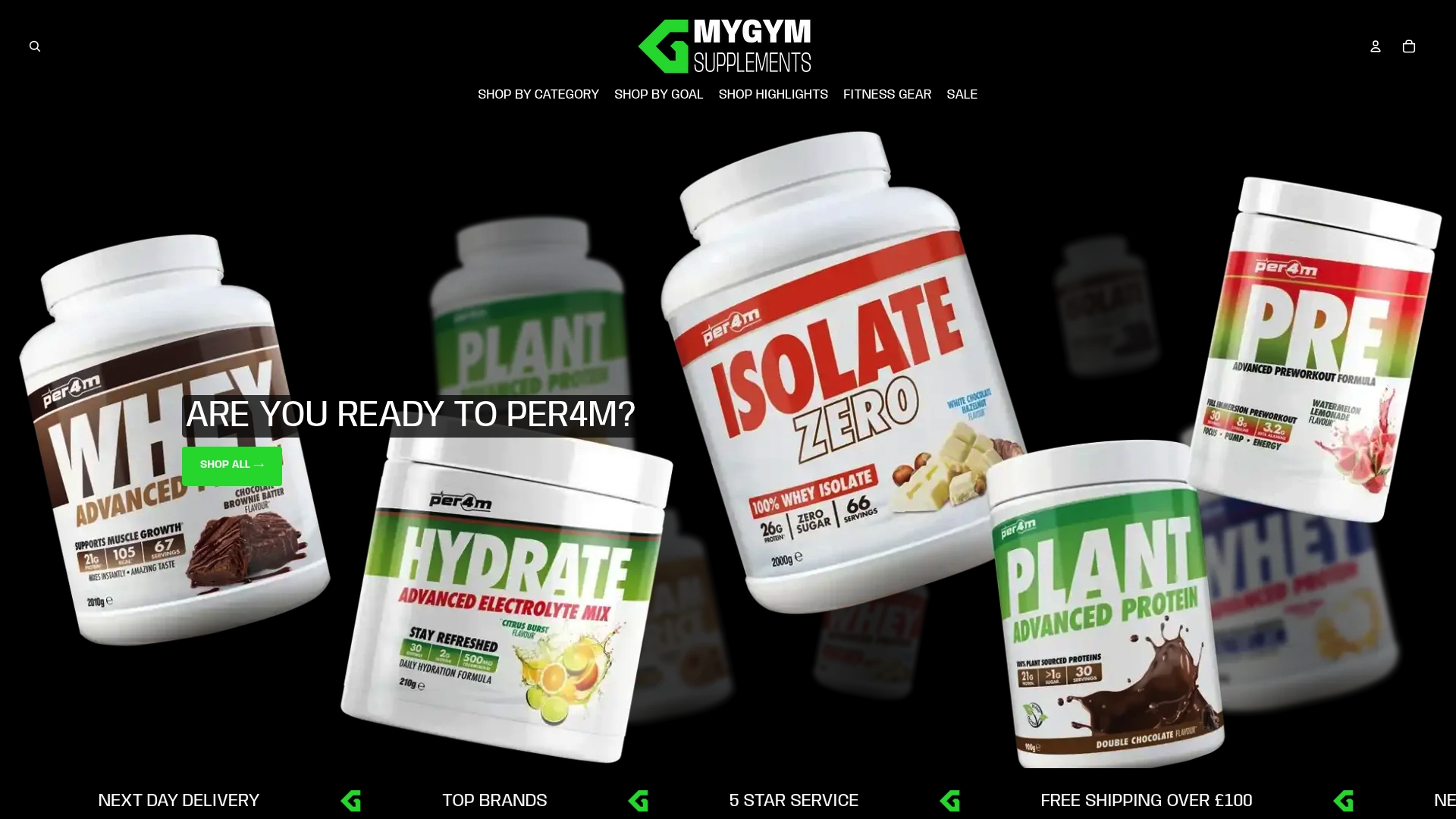Everyone talks about muscle growth after a tough gym session and most focus on what happens during the workout itself. Yet studies show that the real magic may happen in the hour after you finish lifting and not while you are still holding the weights. In fact researchers have found that muscles can absorb nutrients at much higher rates for up to 60 minutes post-workout, unlocking a prime chance for recovery and growth that many miss.
Table of Contents
- Defining The Anabolic Window: Key Concepts
- The Science Behind Muscle Recovery And Growth
- Why The Anabolic Window Matters For Athletes
- Nutritional Strategies During The Anabolic Window
- Common Myths And Misconceptions About The Anabolic Window
Quick Summary
| Takeaway | Explanation |
|---|---|
| The anabolic window lasts 30-60 minutes. | This period is crucial for muscle recovery, highlighting heightened nutrient sensitivity post-exercise. |
| Prioritise protein and carbohydrates post-workout. | Consuming quality protein and fast-absorbing carbs optimises muscle repair and recovery during the anabolic window. |
| Daily nutritional intake matters more than timing. | Overall dietary quality and consistency are vital, reducing the urgency of immediate post-exercise nutrition. |
| Muscle protein synthesis remains elevated post-exercise. | The body maintains an extended period for nutrient uptake beyond the initial 30 minutes after training. |
| Focus on overall dietary quality for muscle growth. | A balanced diet with adequate nutrients supports long-term muscle recovery and performance better than strict timing alone. |
Defining the Anabolic Window: Key Concepts
The anabolic window represents a critical physiological period immediately following intense resistance training, during which your body becomes primed for muscle recovery and growth. Understanding this concept is fundamental for athletes and fitness enthusiasts seeking optimal muscle development and performance enhancement.
What Exactly is the Anabolic Window?
The anabolic window refers to a specific timeframe after exercise where muscle tissues demonstrate heightened sensitivity to nutrients, particularly protein and carbohydrates. Research from the International Society of Sports Nutrition suggests this period typically spans between 30 to 60 minutes post-workout, characterised by elevated muscle protein synthesis rates and enhanced nutrient absorption potential.
Key characteristics of the anabolic window include:

- Increased muscle protein synthesis rates
- Enhanced glycogen replenishment
- Accelerated nutrient uptake by muscle cells
- Improved protein absorption efficiency
Physiological Mechanisms Behind the Concept
During intense resistance training, muscle tissues experience microscopic damage and glycogen depletion. This metabolic stress triggers a cascade of hormonal and cellular responses designed to repair and rebuild muscle protein structures. Consuming high-quality protein and carbohydrates during this window can potentially optimise these recovery processes.
The science suggests that immediately following exercise, your muscles become more receptive to nutrient absorption, creating an optimal environment for muscle protein synthesis.
For those interested in understanding the underlying biological processes, learn more about muscle protein synthesis and how nutrients interact with muscle recovery mechanisms.
While traditional interpretations emphasised a strict 30-minute post-workout nutrition window, contemporary research indicates that the anabolic response is more nuanced. The total daily protein intake and consistent nutrition remain paramount for muscle growth and recovery, suggesting that nutrient timing is important but not as critically time-sensitive as previously believed.
The Science Behind Muscle Recovery and Growth
Muscle recovery and growth represent complex physiological processes involving intricate cellular mechanisms that transform physical stress into adaptive muscular development. Understanding these processes enables athletes and fitness enthusiasts to optimise their training strategies and nutrition approaches.
Muscle Protein Dynamics
Research from the National Institutes of Health reveals that muscle growth fundamentally occurs through a delicate balance between muscle protein synthesis and muscle protein breakdown. When resistance training induces microscopic muscle damage, the body initiates a sophisticated repair mechanism designed to rebuild and strengthen muscle tissues.
Key processes in muscle protein dynamics include:
- Activation of satellite cells for muscle repair
- Hormonal signalling triggering protein synthesis
- Cellular protein remodelling
- Mitochondrial adaptation and energy system enhancement
Hormonal and Cellular Responses
Resistance training stimulates the release of critical anabolic hormones like testosterone and growth hormone, which play pivotal roles in muscle reconstruction. These hormones interact with cellular receptors, triggering protein synthesis pathways that ultimately contribute to muscle hypertrophy.
For fitness enthusiasts seeking deeper insights, explore our comprehensive guide on muscle hypertrophy to understand the intricate mechanisms behind muscle growth.
The body’s adaptive response involves not just protein synthesis but also enhanced nutrient partitioning, where consumed proteins and carbohydrates are strategically directed towards muscle repair and growth. Consistent, progressive resistance training combined with adequate nutritional support creates an optimal environment for continuous muscular development.
To clarify the physiological mechanisms at play, the following table summarises key hormonal and cellular responses after resistance training and their role in muscle adaptation.
| Mechanism | Description |
|---|---|
| Muscle Protein Synthesis | Increased production of muscle proteins to repair and grow muscle tissue |
| Hormonal Signalling | Release of testosterone and growth hormone stimulates anabolic pathways |
| Activation of Satellite Cells | Muscle stem cells involved in repair and regeneration of damaged fibres |
| Glycogen Replenishment | Restoration of depleted muscle energy stores through carbohydrate intake |
| Enhanced Nutrient Uptake | Muscle cells become more receptive to absorbing amino acids and glucose |
| Cellular Protein Remodelling | Adaptation of muscle cell structures for improved strength and function |
Why the Anabolic Window Matters for Athletes
Athletes across various disciplines recognise the critical role nutrition plays in performance, recovery, and muscular development. The anabolic window represents a strategic opportunity to maximise these physiological adaptations through targeted nutritional interventions.
Performance and Recovery Optimization
Research from the International Journal of Sport Nutrition and Exercise Metabolism demonstrates that precise nutrient timing can significantly impact an athlete’s ability to recover, rebuild, and prepare for subsequent training sessions. The anabolic window provides a unique metabolic environment where muscles are exceptionally receptive to nutritional inputs.
Key performance benefits include:
- Accelerated muscle glycogen replenishment
- Enhanced muscle protein synthesis rates
- Reduced muscle soreness and inflammation
- Improved overall recovery efficiency
Nutritional Strategies for Athletes
Professional athletes and serious fitness enthusiasts understand that post-exercise nutrition is more than simply consuming calories. It involves strategic macronutrient selection that supports rapid muscle repair and growth. Consuming a combination of high-quality proteins and fast-absorbing carbohydrates during this critical window can help mitigate muscle protein breakdown and stimulate recovery processes.
For athletes looking to further understand their nutritional requirements, check out our comprehensive guide on vitamins for bodybuilders, which provides additional insights into supporting athletic performance through targeted supplementation.
While the traditional view of the anabolic window suggested a strict 30-minute post-exercise nutritional intake, contemporary research indicates a more nuanced approach. Total daily nutrient consumption and overall dietary quality remain paramount, suggesting that athletes should focus on consistent, high-quality nutrition rather than obsessing over exact timing windows.
Nutritional Strategies During the Anabolic Window
Nutrition plays a pivotal role in maximising muscle recovery and growth during the critical post-exercise period. Strategic nutrient intake can significantly influence the body’s physiological response to resistance training, determining the effectiveness of muscle protein synthesis and overall athletic adaptation.
Macronutrient Composition
Research from sports nutrition experts highlights that the ideal post-workout nutrition involves a precise blend of proteins and carbohydrates. Protein quality becomes paramount, with fast-absorbing proteins like whey providing rapid amino acid delivery to muscle tissues.
Key nutritional considerations include:
- Selection of high-biological value proteins
- Fast-absorbing carbohydrate sources
- Balanced macronutrient ratios
- Minimising potential digestive interference
Protein and Carbohydrate Intake Strategies
Professional athletes and fitness enthusiasts understand that not all protein sources are created equal. Whey protein isolates, known for their rapid absorption rates, stand out as an optimal choice during the anabolic window. Complex carbohydrates complement protein intake by replenishing glycogen stores and supporting insulin-mediated nutrient transportation.
For individuals seeking to optimise their nutritional approach, explore our comprehensive guide on high protein diets to understand how strategic protein consumption can enhance recovery and muscle development.
Individual nutritional requirements vary based on factors like training intensity, body composition, and specific fitness goals.
 While general guidelines suggest consuming 20-30 grams of protein within the post-exercise window, personalised nutrition remains key to maximising physiological adaptations and long-term athletic performance.
While general guidelines suggest consuming 20-30 grams of protein within the post-exercise window, personalised nutrition remains key to maximising physiological adaptations and long-term athletic performance.
Common Myths and Misconceptions about the Anabolic Window
The concept of the anabolic window has been surrounded by numerous fitness myths and oversimplified interpretations that can mislead athletes and fitness enthusiasts about optimal nutrition and recovery strategies. Understanding the nuanced scientific reality is crucial for making informed decisions about post-exercise nutrition.
Debunking the 30-Minute Myth
Contemporary research from sports nutrition studies challenges the rigid belief that nutrients must be consumed within an extremely narrow 30-minute window post-exercise. The traditional strict timeframe is significantly less critical than previously believed, with overall daily protein intake and nutritional quality playing a more substantial role in muscle recovery and growth.
Common misconceptions include:
- Believing missing the post-workout window destroys muscle gains
- Assuming protein absorption stops after 30 minutes
- Thinking more protein always equals better results
- Neglecting total daily nutritional intake
Scientific Perspective on Nutrient Timing
Professional nutritionists and exercise physiologists now emphasise a more holistic approach to nutrition. The body’s muscle protein synthesis mechanisms remain elevated for several hours post-exercise, offering a more extended period for nutrient absorption and utilisation. This understanding fundamentally challenges the previously rigid interpretation of the anabolic window.
The following table compares traditional and contemporary views on the anabolic window, providing a concise overview for readers.
| Aspect | Traditional View | Contemporary Perspective |
|---|---|---|
| Timeframe | Strict 30 minutes post-exercise | 30-60 minutes or more; flexible window |
| Criticality | Urgent; immediate nutrient intake essential | Important, but total daily intake more significant |
| Nutrient Absorption | Rapidly declines after 30 minutes | Remains elevated for several hours post-exercise |
| Risk of Missing Window | Could lead to diminished muscle gains | Minimal risk if overall nutrition is adequate |
| Focus | Exact nutrient timing | Overall dietary quality and consistent protein consumption |
For those seeking deeper insights into nutritional strategies, explore our comprehensive guide on mass gainers to understand how strategic nutritional supplementation supports muscle development beyond simplistic timing models.
While precise nutrient timing remains beneficial, athletes should prioritise consistent, high-quality nutrition distributed throughout the day. The key is maintaining a balanced diet that supports overall metabolic requirements and provides adequate protein, carbohydrates, and essential nutrients for optimal performance and recovery.
Take Full Advantage of Your Anabolic Window
Have you ever felt unsure about how to make the most of the anabolic window after a tough workout? Many athletes and fitness enthusiasts struggle to find the right supplements that support fast muscle recovery and promote muscle growth. The article highlighted how important nutrient timing and quality are for results. If you have ever been confused by myths about the post-workout window or struggled to pick the right protein or recovery product, you are not alone. The good news: science now points to smarter nutrition choices, tailored to your personal needs and recovery timing, as the real key to unlocking progress.

You can now turn your hard work into real muscle gains and better recovery with the correct nutritional support. At MyGymSupplements.shop you will discover a dedicated range of high-quality proteins, amino acids, and performance recovery supplements that help you maximise your anabolic window and accelerate recovery after every session. Explore our platform today to find products specifically formulated for post-workout benefits and visit our informative resource on muscle protein synthesis to further support your fitness journey. Take action now to experience what effective nutrition can do when it matters most. Shop your recovery and muscle gain essentials at MyGymSupplements.shop and feel the difference in your next workout.
Frequently Asked Questions
What is the anabolic window?
The anabolic window is a critical period immediately following intense resistance training when muscle tissues are highly sensitive to nutrients, optimising recovery and growth, typically lasting 30 to 60 minutes post-workout.
Why is the anabolic window important for athletes?
It allows athletes to enhance muscle recovery, improve protein synthesis rates, replenish glycogen, and reduce muscle soreness, which all contribute to better performance and adaptation after training.
What should I consume during the anabolic window?
During the anabolic window, it is recommended to consume high-quality proteins and fast-absorbing carbohydrates to support rapid muscle repair and glycogen replenishment.
How long does the anabolic window last?
While the traditional view suggested a strict 30-minute timeframe post-exercise, contemporary research indicates that the anabolic response can extend for several hours, making overall daily protein intake and nutrition more significant than strict timing.
Recommended
- What is Muscle Protein Synthesis? Understanding Its Importance – MyGymSupplements
- What is Protein Synthesis? Understanding Its Importance – MyGymSupplements
- 7 Top Vitamins for Bodybuilders to Boost Performance – MyGymSupplements
- What is Muscle Hypertrophy? Understanding Its Importance – MyGymSupplements



0 comments